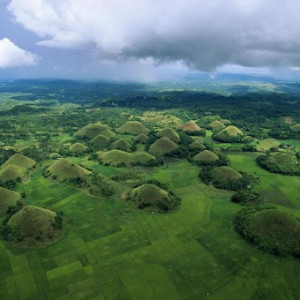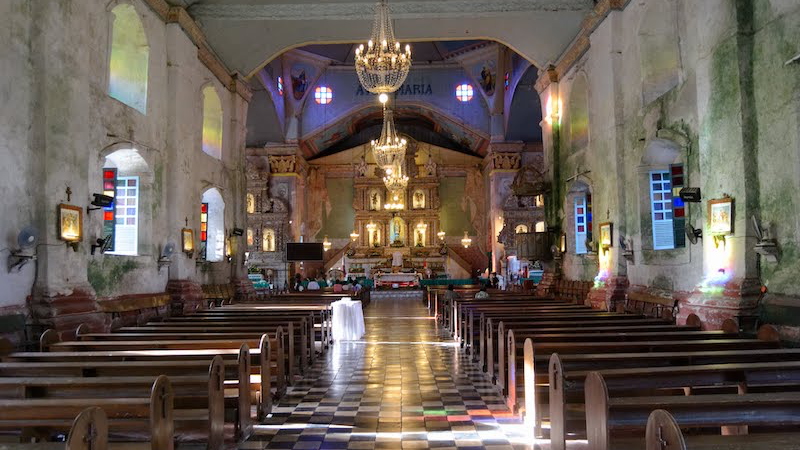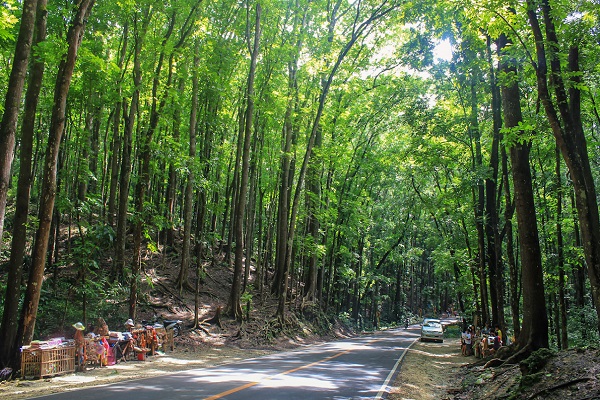- Bohol
- What to Do in Bohol
- Shopping
- Bohol Delicacies
Bohol Delicacies- Must-have Treats and Pasalubongs
Secure your Cebu Bohol ferry tickets today to start your unforgettable journey!
Bohol, a province in the Philippines, is not only known for its stunning natural attractions but also for its delightful delicacies and unique souvenirs. When visiting Bohol, you'll be captivated by the array of local treats that make perfect pasalubong, or souvenirs, to bring back home. From mouthwatering sweets to intricately crafted products, Bohol offers a diverse range of delicacies and souvenirs that reflect the rich cultural heritage and craftsmanship of the province. These delightful items serve as a delicious reminder of your time in Bohol and make excellent gifts for family and friends.
Aside from the famed dolphin watching or the notable diving spots and natural wonders, Bohol is further known for its festivities and merry-making. And one thing to boast upon is the native mouth-watering delights that are already been recognized worldwide as signature "Boholano Delicacies".
As you would always know, food complements every get-together. So when in vacation, appropriate enough budget for this. As you visit Bohol, never forget to taste some of the mouth delectation. And bring some as “pasalubong” for your loved ones who are not as lucky as you are. At least, let them taste Bohol.
Here are some of Bohol’s delicacies and must-have pasalubongs:
Bohol Peanut Kisses

Peanut Kisses, also known as "biskwit nga mani" in the local dialect, is a popular delicacy from Bohol, Philippines. It is a bite-sized cookie made primarily from peanuts, sugar, and egg whites. Peanut Kisses are shaped like little kisses, hence their name.
The making of Peanut Kisses involves a simple yet meticulous process. The peanuts are roasted to enhance their flavor and then finely ground into a powder. The powdered peanuts are mixed with sugar, creating a sweet and nutty base. The egg whites are then added to bind the mixture together. The resulting dough is carefully shaped into small, rounded mounds resembling Hershey's Kisses chocolates. These mounds are then baked until they acquire a light, golden-brown color and a slightly crisp texture.
Peanut Kisses are known for their distinct taste and texture. They have a delicate crunch on the outside, giving way to a melt-in-your-mouth sensation as you bite into the cookie. The combination of the sweet, nutty flavor of the peanuts with the subtle sweetness from the sugar makes Peanut Kisses a delightful treat for peanut lovers.
This delectable Boholano delicacy has gained popularity not only among locals but also among tourists and visitors to the province. It is often enjoyed as a snack, dessert, or a sweet token to bring home as a souvenir. Peanut Kisses can be found in local markets, souvenir shops, and even in some grocery stores, packaged in colorful boxes, making them an ideal gift or pasalubong.
The popularity of Peanut Kisses has extended beyond Bohol, with people from different parts of the Philippines and even abroad becoming fans of this unique cookie. Its distinct taste and the craftsmanship behind its creation have made it an iconic treat that represents the culinary heritage of Bohol.
So, the next time you visit Bohol or come across Peanut Kisses, be sure to indulge in this delightful local delicacy. Experience the combination of flavors and the love put into crafting each little kiss-shaped cookie, and savor a piece of Bohol's culinary tradition.
Calamay
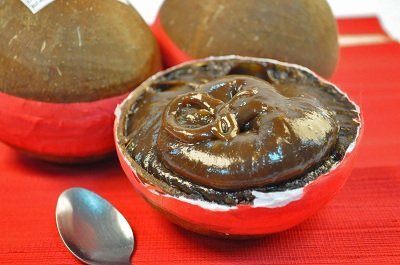
Calamay is a sweet and sticky rice cake that is popular in Bohol and other regions in the Philippines. It is a traditional delicacy made from glutinous rice, coconut milk, and sugar. Calamay is known for its rich and creamy texture, as well as its delightful sweetness.
The process of making calamay involves several steps. First, glutinous rice is soaked in water and ground into a fine paste. The rice paste is then mixed with coconut milk and sugar, creating a smooth and thick mixture. The mixture is then cooked over low heat, stirring continuously until it thickens and reaches the desired consistency.
The key to achieving the perfect calamay lies in the slow and patient cooking process. The continuous stirring prevents the mixture from sticking to the pan and ensures even cooking. The result is a luscious and gooey rice cake with a slightly caramelized flavor.
Calamay is traditionally wrapped in banana leaves or coconut husks, giving it a rustic and charming appearance. It is often molded into small, rectangular shapes, making it convenient to enjoy as a handheld snack. The texture of calamay is sticky and chewy, providing a delightful contrast to its sweet taste.
In Bohol, calamay is commonly enjoyed during special occasions and festivities. It is often given as a gift or pasalubong to friends and relatives. It is also a popular treat during fiestas and celebrations, where it is shared and enjoyed by the community.
If you have the opportunity to visit Bohol or come across calamay in local markets or stores, be sure to give it a try. Experience the unique texture and taste of this traditional Filipino rice cake and appreciate the culinary heritage it represents. Calamay is a sweet indulgence that captures the essence of Bohol's rich culinary traditions.
Recommended Bohol Philippines Tours
[ Bohol Sight Seeing Day Trips - Check Out Availability ]
[ Full Day Cruise and Sailing Tours - Check out Availability ]
[ Full Day Adventure Tours - Check out Availability ]
Discover more of Bohol's natural wonders through our recommended tours. Click on the links below to embark on unforgettable adventures:
Ready to explore the beautiful islands of Cebu and Bohol? Secure your ferry tickets today through 12go and start your unforgettable journey!
Ube Kinampay

Ube kinampay, also known as purple yam or Dioscorea alata, is a special variety of yam that is native to Bohol, Philippines. It is highly esteemed for its vibrant purple color, sweet flavor, and unique aroma. Ube kinampay holds a significant place in Bohol's culinary and cultural heritage.
The tubers of the ube kinampay are characterized by their smooth and round shape, ranging in color from marbled purple-white to deep purple. They are composed of approximately 70% water and are rich in calcium, vitamins, and proteins. The high concentration of glucose in the tuber contributes to its natural sweetness.
What sets ube kinampay apart is the specific environment in Bohol's Panglao Island and Guindulman, where it is primarily cultivated. The sandy loam or silt loam soil and the favorable temperatures ranging from 25 to 30 degrees Celsius play a significant role in shaping the distinct characteristics of ube kinampay. Attempts to cultivate the same variety of ube elsewhere in the country have not yielded the same taste and aroma.
Boholanos have a deep appreciation for ube kinampay, considering it a sacred and godsent product. It is revered as an "agro-historical-geographical-religious" symbol by the local community. Traditional stories and beliefs have attributed ube kinampay with the ability to save locals from hardships such as famine, drought, and war. It has become a customary practice, even among children, to kiss the ube kinampay whenever it accidentally falls to the ground.
In Bohol, ube kinampay is not only enjoyed in its simplest form but also transformed into various delectable treats. It is commonly used as the main ingredient in popular desserts like ube halaya or jam, ice cream, pastillas, and polvoron. The tuber's skin is even utilized as a raw material for food coloring.
The demand for ube kinampay remains high, both locally and globally. The Department of Agriculture estimates an annual export demand of 49,000 tons, including different forms such as cubes, powder, puree, flakes, or flour. Additionally, the annual Ubi Festival is celebrated to promote awareness and appreciation for this beloved purple yam, allowing farmers to showcase their products and share their knowledge with visitors.
Carabao Milk In Ubay
Ubay, a municipality located in the province of Bohol, is known for its thriving carabao milk industry. Carabaos, also known as water buffalos, are prized for their milk, which is highly regarded for its rich flavor and nutritional value.
In Ubay, carabao milk is collected from local farmers who rear and care for these gentle creatures. The milk is obtained through a process called milking, where skilled farmers extract the fresh milk from the carabaos using specialized techniques.
The carabao milk from Ubay is cherished for its creamy texture and distinct taste. It is often used to create various dairy products such as carabao milk cheese, yogurt, pastillas (milk candies), and even ice cream. The versatility of carabao milk allows for a wide range of culinary possibilities.
The dairy products made from carabao milk in Ubay are sought-after by both locals and visitors. They offer a unique and flavorful twist to traditional dairy products, showcasing the richness and quality of the carabao milk produced in the region.
If you happen to visit Ubay, make sure to explore the local markets or visit dairy farms where you can sample and purchase these delicious carabao milk products. Supporting the carabao milk industry not only allows you to savor the distinct flavors but also contributes to the livelihoods of the local farmers and the preservation of the carabao farming tradition in Ubay.
So, whether you enjoy carabao milk as a refreshing beverage, a creamy dessert, or a savory ingredient in your favorite dishes, Ubay's carabao milk products are sure to leave a lasting impression with their unique taste and contribution to Bohol's agricultural heritage.
Mud Crab Of Loay
Loay, a municipality located in the province of Bohol, is renowned for its abundant mud crab (Scylla serrata) population. Mud crabs, locally known as "alimango," are highly valued for their succulent meat and are considered a delicacy in Filipino cuisine.
The mud crabs of Loay are known for their exceptional quality and size, making them a sought-after seafood delicacy. They are typically found in the mangrove forests and estuaries surrounding the municipality, where they thrive in the brackish water conditions.
Local fishermen in Loay employ various methods to catch mud crabs, including crab pots, nets, and traditional bamboo traps. These methods ensure the sustainability of the crab population and help maintain the ecological balance of the area.
Once caught, the mud crabs are usually prepared in a variety of mouthwatering dishes, such as steamed crabs, crab soup, crab adobo, or buttered crabs. The sweet and tender meat of the mud crab is highly prized and often enjoyed with dipping sauces or served alongside other seafood and vegetables.
If you visit Loay or nearby areas in Bohol, don't miss the opportunity to savor the delectable mud crabs it has to offer. Local restaurants, seafood markets, and resorts often feature mud crab dishes on their menus, allowing you to experience the unique flavors and culinary delights of this prized seafood.
Whether you're a seafood lover or simply curious about trying local delicacies, indulging in the mud crabs of Loay promises a memorable dining experience that showcases the rich seafood heritage of Bohol.
Alupe
Alupe, also known as alupi in the Ilonggo dialect, is a delightful treat made from cassava mixed with milk and sugar. This delicacy can be purchased from local vendors or prepared in the comfort of your own kitchen. However, it is most renowned in the town of Bilar, where it has gained popularity among locals and visitors alike.
Alupe is commonly enjoyed as a snack or dessert, perfect for satisfying your sweet tooth after a hearty meal. The combination of cassava's subtle flavor, the creaminess of milk, and the touch of sweetness from sugar creates a delightful harmony of tastes and textures.
To make alupe, the cassava is first grated and then mixed with milk and sugar to form a thick batter. This mixture is then steamed or baked until it reaches a soft and slightly chewy consistency. The end result is a delectable treat that can be enjoyed on its own or paired with a hot beverage for a comforting indulgence.
If you find yourself in Bilar or come across alupe in other parts of Bohol, be sure to give it a try. This local specialty offers a unique taste experience that showcases the versatility of cassava and the creativity of Bohol's culinary traditions.
Broad (Lady Fingers)

A cookie, native from Baclayon, soft in texture that literally melts in your mouth once you take a bite. It is light and crisp, perfect for snacks with milk, coffee or hot chocolate. It is also recommended in making Mango Refrigerator Cake.
Bibingka
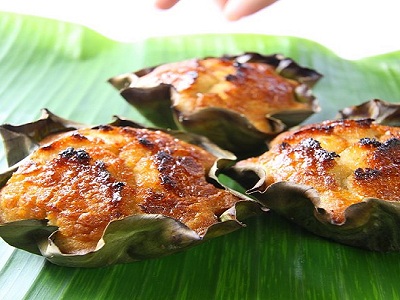
There are so many versions of this Philippine treat but basically, it is composed of rice flour, sugar, butter and coconut milk wrapped in banana leaves. It is served as “painit” in early in the morning paired with hot coffee or chocolate or an afternoon snack with cold softdrinks.
Maruya (Banana Flitters)

These are among the favorites, not just to the children but to adults as well. Made from Saba bananas, dipped in a sticky mixture, fried and then rolled in sugar, it is perfect for everyday snacks and healthy too.
Biko

A famous Filipino recipe and can be seen in almost all Filipino celebrations. It is made of glutinous rice, coconut milk, sugar (latik).
Torta
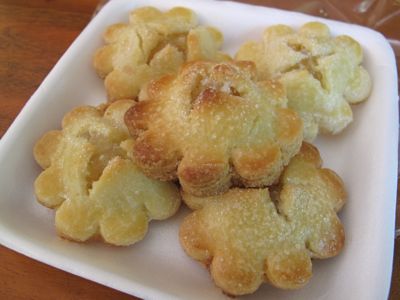
Merienda time is torta time. In Bohol you can taste one of the best-tasting tortas in the country. Torta means “cake” in Spanish. It is soft, fluffy, moist and easy to swallow.
Check out These Other Bohol Delicacies
- Bohol Delicacies
- Pastries of Baclayon
- Purple Yam of Dauis Bohol
- Bohol Purple Yam Ubi Kinampay
- Bohol's Ubi Festival
- Filipino Cuisine- Bohol-Philippines
- Culinary Gem - Alona Beach, Panglao Island
- Products of Bohol Philippines
- Bohol Culture
- Peanut Kisses- The Best Take-Home Snack
- Calamay- Bohol's Must-Have Treat
- Bohol Shopping Souvenirs: Where to Buy the Best Gifts and Treasures
- Bohol Ube or Purple Yam
- Bohol Freshwater Fish
Check out for Bohol Hotel Deals
Ready to explore the beautiful islands of Cebu and Bohol? Secure your ferry tickets today through 12go and start your unforgettable journey!
recommended hotel booking
Book your stay in Bohol's breathtaking surroundings through Agoda and experience the ultimate relaxation
Top 25 Sights and Attractions in Bohol
- Chocolate Hills
- Tarsier Conservation Sanctuary
- Panglao Island
- Loboc River Cruise
- Hinagdanan Cave
- Balicasag Island
- Alona Beach
- Bilar Man-made Forest
- Blood Compact Shrine
- Baclayon Church
- Bohol Bee Farm
- Anda Beach
- Sipatan Twin Hanging Bridge Loboc
- Danao Adventure Park
- Sagbayan Peak
- Butterfly Conservation Center
- Clarin Ancestral House
- Dimiao Twin Falls
- Mag-Aso Falls
- Anda White Beach
- Lamanok Island
- Rajah Sikatuna Protected Landscape
- Dauis Church
- Can-umantad Falls
- Punta Cruz Watchtower
Top 20 Destinations of Bohol
- Tagbilaran City
- Panglao Town
- Talibon Town
- Anda Town
- Loboc Town
- Dauis Town
- Ubay Town
- Tubigon Town
- Loon Town
- Jagna Town
- Alicia Town
- Carmen Town
- Getafe
- Danao Town
- Bilar
- Alburquerque
- Sierra Bullones
- Sagbayan Town
- Baclayon Town
- Antequera
Ready to explore the beautiful islands of Cebu and Bohol? Secure your ferry tickets today through 12go and start your unforgettable journey!
All Rights Reserved ©2023. Bohol Philippines Travel Guide
Address: Talibon, Bohol, Philippines

